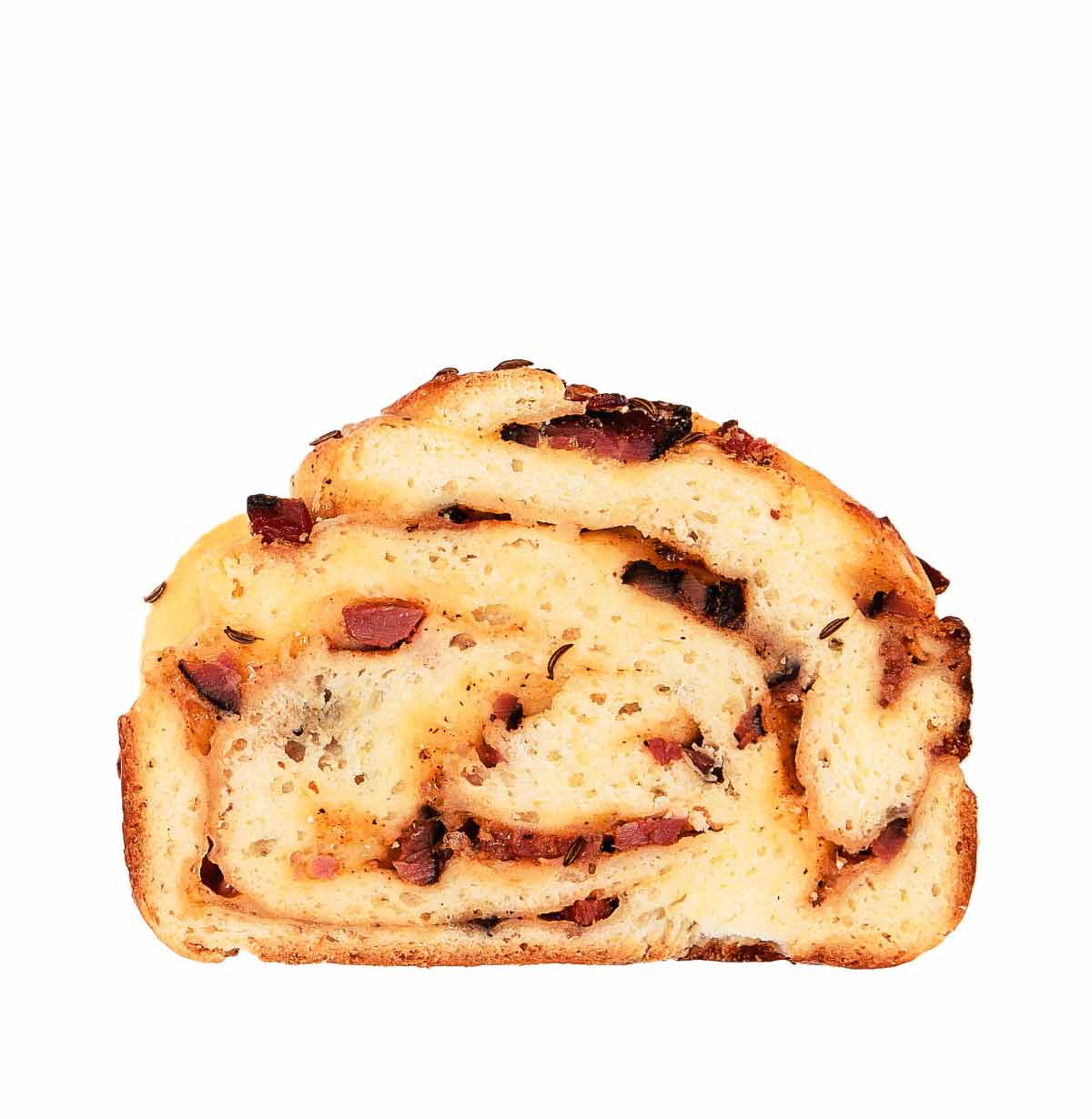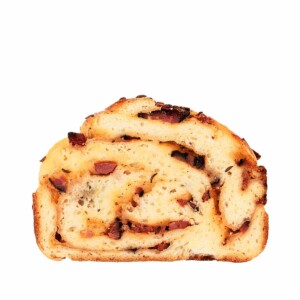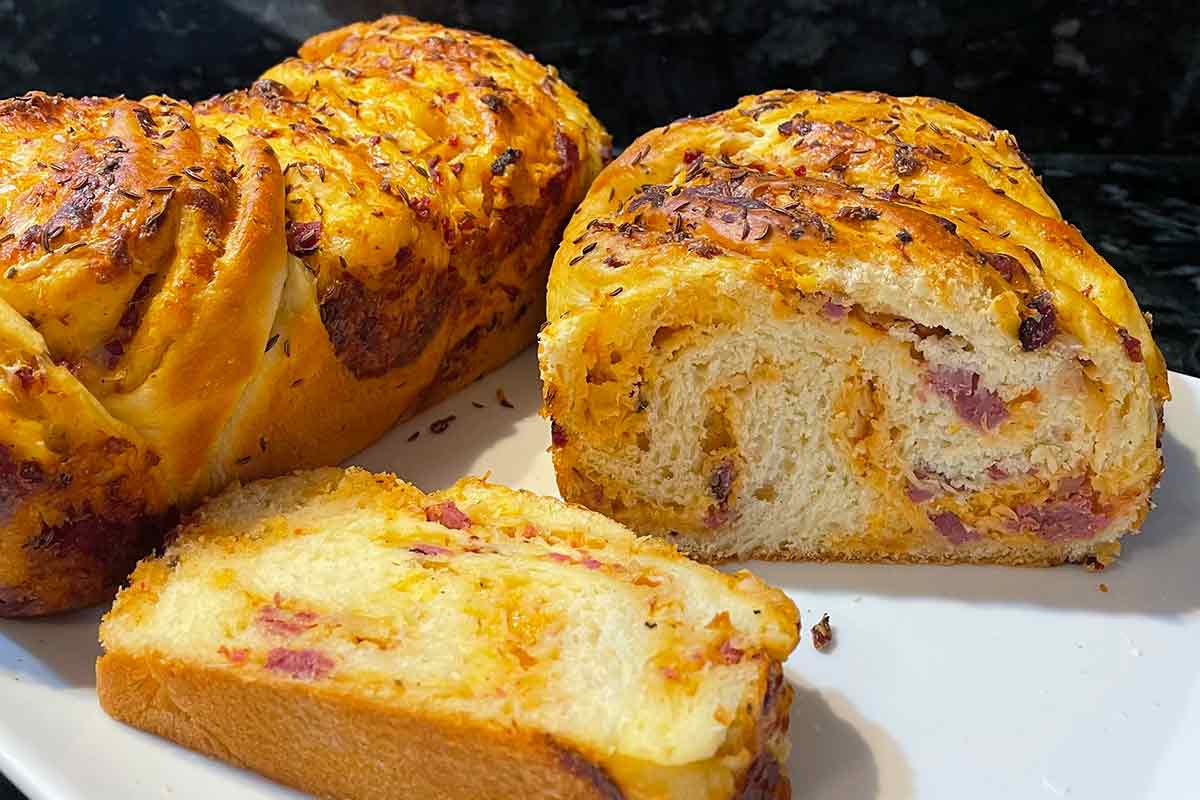Reuben Babka
Posted by admin on
Reuban babka takes the soft, fluffy dough of a traditional babka and fills it with pastrami, Swiss cheese, sauerkraut, mayo, ketchup, Dijon, and caraway seeds. Our testers loved it, we know you will too.

Adapted from Jake Cohen | Jew-ish | Mariner Books, 2021
What makes babka so beautiful is how customizable it is. Long gone are the days of Seinfeld, when your only choices were chocolate or cinnamon! After tweaking and perfecting my base dough, I began pushing the boundaries of what I could twist between these fluffy layers: Silky tahini was swirled into chocolate ganache, cinnamon was used to spice a pumpkin filling for a fall-baking vibe, and I entered the magical world of savory babkas, spreading pistachio pesto studded with sun-dried tomatoes on the dough and, finally, baking this loaf packed with all the flavors of the classic reuben.—Jake Cohen
Reuben Babka FAQs
To be sure your babka is cooked through, use an instant-read thermometer to check that the internal temperature is 185℉. This method is also good if you don’t have a toothpick long enough to reach the middle of the loaf.
Don’t skimp on the proof. If you want a fluffy babka, make sure you give it time to rise; how long it needs will fluctuate depending on the time of year and how warm (or cold) your kitchen gets. The visual cues are simple: double in size for the first proof and expand to fill the loaf pans for the second.
Babkas are generally best eaten the same day that they are made. This version will make an incredible grilled or toasted sandwich the next day, however. Or even just toasted and slathered with butter.
Reuben Babka

Ingredients
For the babka
- 1 cup whole milk heated to 115°F (46°C)
- 1/3 cup granulated sugar
- 1 packet (1/4 ounce) active dry yeast
- 1 stick (4 ounces) unsalted butter melted
- 4 large eggs divided
- 5 cups all-purpose flour plus more as needed
- 2 teaspoons kosher salt
- 4 tablespoons mild vegetable oil divided
- 1 tablespoon caraway seeds for garnish
For the Reuben filling
- 12 ounces thick-cut pastrami finely chopped
- 8 ounces Swiss cheese coarsely grated
- 1 cup store-bought or homemade sauerkraut drained
- 1/2 cup store-bought or homemade mayonnaise
- 1/4 cup ketchup
- 1 tablespoon Dijon mustard
Directions
Make the babka
- In the bowl of a stand mixer fitted with the whisk attachment, whisk the warm milk and sugar together. Sprinkle the yeast over the top and let stand until foamy, 5 to 10 minutes.
- Add the melted butter and 3 of the eggs, then whisk until well incorporated. Switch to the dough hook, then add the flour and salt. Beginning on low speed and gradually increasing to medium, knead until a smooth, elastic dough forms, about 5 minutes. If the dough is very sticky, add more flour 1 tablespoon at a time.
- Slick a medium bowl and your hands with 2 tablespoons of the oil. Using your hands, transfer the dough to the bowl, gently turning to coat it with the oil, and shape it into a smooth ball. Cover with plastic wrap or a clean kitchen towel and set aside in a warm place until doubled in size, 1 hour to 1 hour 40 minutes. (Alternatively, you can let the dough rise in the refrigerator, covered, overnight.)
Make the Reuben filling
- While the dough is rising, in a medium bowl, stir together the pastrami, cheese, sauerkraut, mayonnaise, ketchup, and mustard until well combined.
Assemble the babka
- Preheat the oven to 350°F (177°C). Slick two 9-by-5 inch (23-by-13 cm) loaf pans with the remaining 2 tablespoons of oil, using 1 tablespoon for each pan.
- Divide the dough into 2 equal balls. On a lightly floured surface, roll out one ball of dough into a 12-by-14inch (30-by-35 cm) rectangle, about 1/4 inch (6 mm) thick and aligned horizontally.
- Spread half the filling evenly over the surface of the dough, leaving a 1-inch (2.5 cm) border all the way around the rectangle. Starting with the edge closest to you, roll up the dough tightly into a log. Using a serrated knife, carefully cut the roll lengthwise in half. Twist the strands together and pinch the ends to seal. Carefully place the babka in one of the prepared loaf pans.
- Repeat this process with the remaining dough and filling. Cover both babkas loosely with plastic wrap or clean kitchen towels and set aside in a warm area until the dough expands to fill the pan, about 45 minutes.
Bake the babka
- In a small bowl, beat the remaining egg, then liberally brush each babka with the egg and top with caraway seeds. Bake, rotating the pans halfway through, until the babkas are golden and each has reached an internal temperature of 185°F (85°C), 40 to 55 minutes.
☞TESTER TIP: If your loaves begin to darken too much during baking, cover with foil.
- Remove from the oven and let cool slightly in the pans, then remove the loaves from the pans and let cool completely before slicing and serving. Babka is best served the day it’s baked.
Show Nutrition
Recipe Testers’ Reviews
The instructions are well written and the bread itself bakes up evenly with a nice rise, crunchy golden top, and browned hints of what’s inside. The enriched dough is yeasty and sweet which is just sinful when combined with the Reuben filling.

As much as I love this Reuben babka, I keep wondering what it’s meant to be. Too heavy to serve with a meal, not really substantial enough to call it a meal. Maybe that’s just me feeling guilty for indulging myself. It’s certainly a bread to impress though.
In the end, I served this with a huge salad with homemade Thousand Island dressing and grilled a big slice, and served as a giant crouton. It is equally good plain, or with a bit of butter. I have fat kid thoughts of using this bread to make patty melts!
If you are a fan of Rueben sandwiches, you will love this Reuben babka. It’s like a sandwich in a slice. Not to mention that it is a gorgeous loaf of bread after it is baked!
As with all yeast breads, there is a little bit of time and effort involved but the finished product is well worth it. I found it to have a moist, tender crumb and a beautiful golden crust. The Reuben filling comes together quickly and easily and can be done during the rising time for the dough. I’d recommend using more caraway seeds.
My only issue was what to serve it with. I just wasn’t sure what the flavors went with as far as serving it as bread with some other main dish. We ended up eating it primarily as a “snack”. It is delicious with mustard or cheese dip. My husband thinks it would be great with the Mustard Cream Sauce. I would also like to try it as a grilled cheese sandwich using Swiss or some similar cheese. I will definitely be making this again.
Flavor-wise, this Reuben babka is a great recipe! I look forward to doing this one again with other traditional fillings (locally, that’s cream cheese, chocolate, or cinnamon).
There were several challenges with this recipe, but as it turned out, none were insurmountable. First, the control panel for the oven on our range went kerflooey, so all I had to bake in was our GE convection microwave—yes, it does both microwave cooking and convection oven baking. The next challenge came with removing the loaf from the pan. With all the sticky elements in the recipe, I should have let the loaf cool in the pan and get a little firmer before attempting to remove it.
Originally published November 27, 2021

